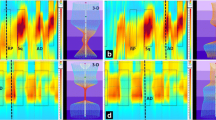Abstract
The use of anorectal manometry as a biofeedback technique in the treatment of constipation and fecal incontinence in patients with spina bifida is described. The technique was applied in ten incontinent spina bifida patients aged 3 to 16 years. To evaluate our results we used the concept of “controlled incontinence,” i.e., voluntary defecation at set times, with the patient remaining “clean” the rest of the time as a base. A total of 80% satisfactory results was obtained.
Similar content being viewed by others
References
Barber TX, Di Cara LV, Kamiya J (1971) Biofeedback and self control. Aldine-Atherton, Chicago
Benson H, Shapiro D, Tursky B (1971) Decreased systolic blood pressure through operant conditioning techniques in patients with essential hypertension. Science 173: 740–742
Bleecker ER, Engel BT (1973) Learned control of cardiac rate and cardiac conduction in the Wolff-Parkinson-White syndrome. N Engl J Med 288: 560–562
Bleecker ER, Engel BT (1973) Learned control of ventricular rate in patients with atrial fibrillation. Psychosom Med 35: 161–175
Budzynski T, Stoyva J, Adler C (1970) Feedback-induced muscle relaxation: application to tension headaches. J Behav Ther Psychiatr 1: 205–211
Cerulli MA, Nikoomanesh P, Schuster MM (1979) Progress in biofeedback conditioning for fecal incontinence. Gastroenterology 76: 742–746
Engel BT, Nikoomanesh P, Schuster MM (1974) Operant conditioning of retrosphincteric responses in the treatment of fecal incontinence. N Engl J Med 290: 646–649
Gil-Vernet JM, Bardaj C, Boix-Ochoa J (1985) Técnicas de biofeedback en la incontinencia de la atresia anorrectal alta. Cir Esp 39: 795–800
Krisst DA, Engel BT (1975) Learned control of blood pressure in patients with high blood pressure. Circulation 51: 370–378
Lang PJ, Melamed BG (1969) Case report: avoidance conditioning therapy of an infant with chronic ruminative vomiting. J Abnorm Psychol 74: 1–8
Olness K, McParland FA, Piper J (1980) Biofeedback: a new modality in the management of children with fecal soiling. J Pediatrics 96: 505–509
Weiss T, Engel BT (1971) Operant conditioning of heart rate in patients with premature ventricular contractions. Psychosom Med 33: 301–321
White JD, Taylor D (1967) Noxious conditioning as a treatment for rumination. Ment Retard 5: 30–33
Author information
Authors and Affiliations
Additional information
Offprint requests to: J. M. Gil-Vernet
Rights and permissions
About this article
Cite this article
Gil-Vernet, J.M., Marhuenda, C., Sanchis, L. et al. Biofeedback in spina bifida. Pediatr Surg Int 7, 30–33 (1992). https://doi.org/10.1007/BF00180998
Accepted:
Issue Date:
DOI: https://doi.org/10.1007/BF00180998




